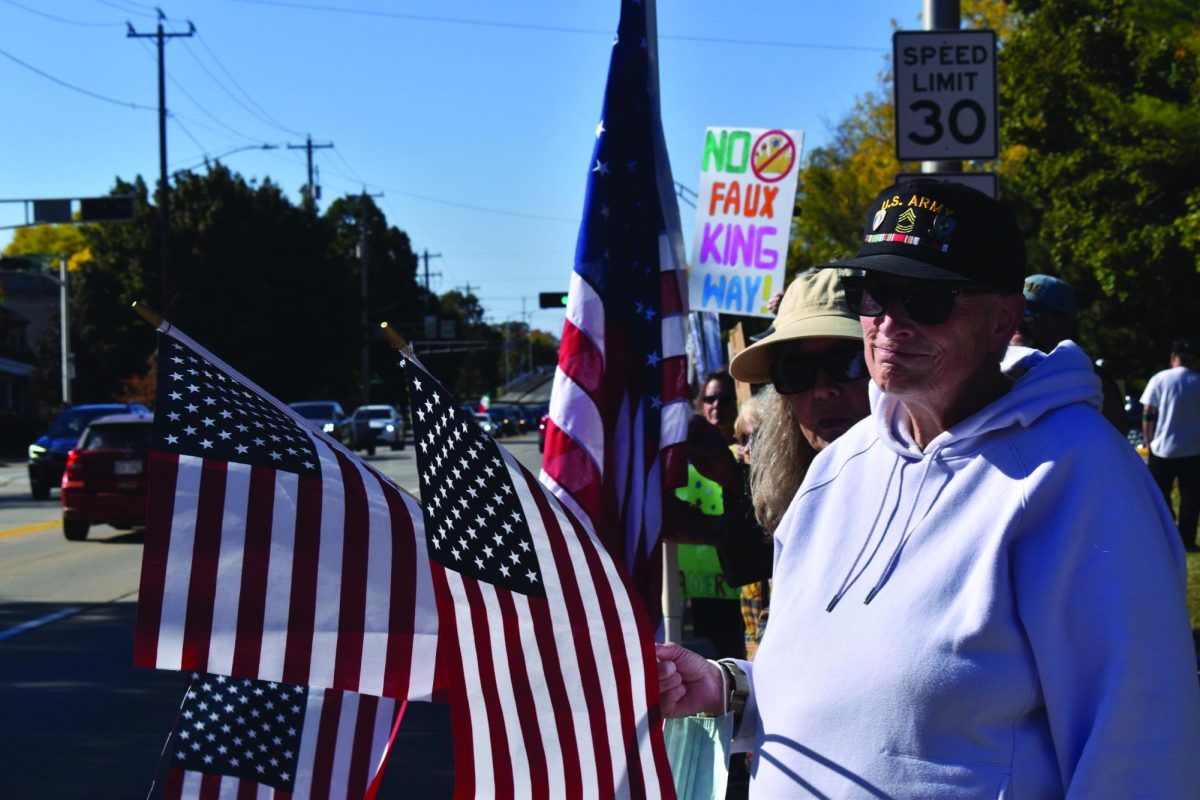“Stay strong; love endlessly; change lives.”
The Experience
The adrenaline is kicking in as I sign the golden yellow waiver understanding the risks involved with my tattoo. The semicolon will be my fifth one. A shop assistant comes over and shows me a drawing of what I want, and I agree to it. They get it ready to put it on a stencil that transfers the outlines to the skin. The tattoo would be $25; $20 of that would be donated to Project Semicolon by Walking Art Tattoo shop owner, Mike Medrano.
The assistant uses an alcohol wipe to clean the skin on my wrist and pours a clear goop on the area, rubbing the cool gel in. She places the stencil down so the blue lines are matched with my skin and presses down. The stencil is held there for a few seconds before peeling the wax paper away. It’s a little off, and the assistant adjusts it a few more times before asking a new artist for help. Finally, it’s adjusted evenly in the center of my wrist, matching the palm of my hand to my elbow.
Holly Stro, a traveling artist from Eau Claire featured at Walking Art Tattoo, pushes the foot pedal, causing the gun to buzz. “Ready?” she asks.
“Yep,” I say, more ready than ever.
Stro laughs after I ask her where all her tattoos are. Wearing a black zip-up hoodie with the sleeves rolled up, a pair of jeans with the ends tattered and an old pair of chucks, it appears as if she has none.
“I have one down my leg,” Stro said, later revealing it’s a sleeve of multiple tattoos, covering both of her legs completely. She dips the needle of the gun into the tiny thimble of black ink. “So, what brings you in here for the semicolon tattoo?”
The Project
Project Semicolon, based in Green Bay, Wisconsin, started in honor of founder Amy Bleuel’s father, who committed suicide when Bleuel was just 18 years old. Her story on the Project Semicolon blog delves into details about her abuse from her stepmother at a young age, her rape when she was 13, her father’s suicide and her 20-year struggle with depression.
“Despite the wounds of a dark past I was able to rise from the ashes, proving that the best is yet to come,” Bleuel wrote on the Project Semicolon website. “When my life was filled with the pain of rejection, bullying, suicide, self-injury, addiction, abuse and even rape, I kept on fighting. I didn’t have a lot of people in my corner, but the ones I did have kept me going.”
Project Semicolon’s website allows people to share their story with the world, their mission stating that this is a “movement dedicated to presenting hope and love for those who are struggling with mental illness, suicide, addiction and self-injury.” The semicolon represents a new beginning.
“I chose a semicolon for mental illness and suicide awareness, because in literature a semicolon is used when an author chooses not to end a sentence,” Bleuel said. “We are saying you are the author and the sentence is your life.”
The project, started in April 2013, has already gained traction with media around the nation and a growing social media audience with a tremendous 27,000 follower base on Instagram. “#ProjectSemicolon” also has almost 23,000 public Instagram posts. Although the website is not a 24-hour helpline, they do offer a number of sources, local, national and international, to those who are looking for help.
“Project Semicolon is a non-profit organization dedicated to presenting hope and love to those who struggle with addiction, depression, suicide and self-injury,” Bleuel said. “Through the power of one’s story we strive to present hope for a better tomorrow. To say you’re not alone. It gets better.”
Those who are looking to get involved with the project can start with donations, spreading the word, getting a tattoo or simply drawing one on themselves.
“Ultimately, it is our hope that people are able to share their stories,” Bleuel said.
The Stories
“All I had to do was kick the chair out from under my feet,” Clara Roberts, whose name has been changed to protect her identity, said. Now 25, Roberts is living a life as a newlywed in Oshkosh, Wisconsin. She works full-time as a certified nursing assistant at the Winnebago County Mental Health Hospital after receiving her psychology degree from the UW- Whitewater.
“My dad was verbally and emotionally abusive to me,” Roberts said, playing with the rubber band around her wrist. “I guess I was physically abused, too, but I can’t remember that.”
From middle school to her freshman year in college, her parents’ custody agreement forced her to live with her father after their divorce. At 18 years old, although legally an adult, Roberts’ father forced her to not see her mom. At 19, she ran away from home when she met Mike, her husband.
Her stepmom harasses her to this day. The last time Roberts heard from her stepmom was her wedding day when Roberts’ best friend received a phone call; a conversation filled with messages like, “I hope lightning strikes the church.” Roberts started snapping the rubber band on her wrist, talking about how she still has siblings living in that environment and how she can’t help them until they are older.
“He and my stepmom are doing things to my sisters,” Roberts said, a defeated tone. “Out of my dad’s five children, three have had suicidal thoughts.”
Roberts heard about the project from her work mentor, who had the tattoo and explained to her what the meaning was all about.
“You have to stay strong because we can all live through it,” Roberts said, smiling. Her tattoo is on the inner part of her upper arm and states, “Stay Strong;” in script.
Molly Smith, whose name has been changed to protect her identity, began experiencing depression in her freshman year of college at UW-River Falls. Smith was suspended for not reaching academic standards and was sent home to Minocqua, Wisconsin.
“And when I was home that year going to Nicolet [Technical College], I honestly felt worthless and like I failed myself,” Smith said. “Along with dealing with stress in my family and being away from friends, and the place I considered home.”
Smith is one of the youngest siblings in her family of five, and a twin to Michael, whose name has also been changed to protect his identity. Her father was diagnosed with multiple sclerosis when she was in high school and has been in a wheelchair or forearm crutches since.
“I attempted suicide, but Michael walked in on me not knowingly, and stopped me,” Smith said. “A few years later and one of my best friends tried suicide and was sent to the hospital. I was 10 minutes late from stopping her and it killed me for a long time. Then this last year, my close friend was having suicidal thoughts so I was constantly running to her house. We worked things out, but it was painful.”
This year, Smith stopped another friend from an attempted overdose, so the semicolon was one that was important to her and others she knew.
“For me, I got the semicolon not just for myself, but for my friends and loved ones,” Smith said. “To me, I love the meaning behind, ‘your story isn’t over yet,’ and I firmly believe in that.”
Smith currently attends UW-River Falls and is pursuing her degree in communications. Her semicolon is small and located on the nape of her neck.
The Statistics
According to the Centers for Disease Control, suicide was the tenth leading cause of death for all ages in 2013, a staggering number of 41,149. The CDC states it was 113 suicides per day, or one every 13 minutes.
The CDC stated 17 percent of students in grades nine through 12 “seriously considered attempting suicide in the pervious 12 months” in 2013. 13.6 percent of students actually made a plan about how they would attempt suicide and 8 percent of them attempted.
There are even gender distinctions in suicides. The CDC reported that males are four times more likely to commit suicide than females are, leading the suicide rate at 77.9 percent. However, females will have more suicidal thoughts than males. Firearms are more common in suicide methods for males, whereas poison is the most common for women.
My Story
The tattoo shop smells like wood and incense, a calming and peaceful scene. There’s Japanese art on the walls, particularly koi fish drawings that Medrano most likely did himself.
At 11 years old, I started having panic attacks. They were so severe that I was taken to a children’s hospital in Marshfield for observations for a few days to make sure there were no heart issues. The anxiety grew from there. In 7th grade, I started self-harming after I dealt with years of bullying.
“Well, I attempted suicide twice in high school,” I told Stro. “Once my sophomore year, and again my senior year.”
In the chair, I thought back to high school. Sophomore year included a mentally abusive relationship that turned physical at the end. It included drinking at parties in the woods, getting high and a sexual assault. It included a phone call with a previous boyfriend telling me I didn’t deserve to live for what I had done. It included a trip in the ambulance and liquid charcoal to help pump my stomach from toxins. It included weekly therapy.
“That’s why I’m getting the tattoo,” I said, smiling. “I’m so blessed to be living my life.”
“I’m glad you’re here then,” Stro said. 10 minutes and the tattoo is over. Stro sprays a yellow soap solution on the paper towel to clean the excess ink off my wrist and tattoo.
“My next tattoo is going to be a quote I was told during therapy,” I said. “I have had no dragons in my life. Only small spiders and stepping in chewing gum. I could have slain dragons.”








